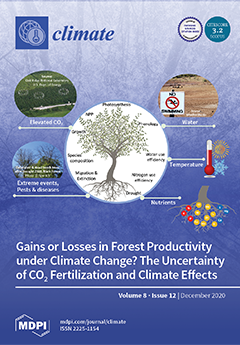The majority of people in South Africa eat maize, which is grown as a rain-fed crop in the summer rainfall areas of the country, as their staple food. The country is usually food secure except in drought years, which are expected to increase
[...] Read more.
The majority of people in South Africa eat maize, which is grown as a rain-fed crop in the summer rainfall areas of the country, as their staple food. The country is usually food secure except in drought years, which are expected to increase in severity and frequency. This study investigated the impacts of rainfall and minimum and maximum temperatures on maize yield in the Setsoto municipality of the Free State province of South Africa from 1985 to 2016. The variation of the agroclimatic variables, including the Palmer stress diversity index (PSDI), was investigated over the growing period (Oct–Apr) which varied across the four target stations (Clocolan, Senekal, Marquard and Ficksburg). The highest coefficients of variance (CV) recorded for the minimum and maximum temperatures and rainfall were 16.2%, 6.2% and 29% during the growing period. Non-parametric Mann Kendal and Sen’s slope estimator were used for the trend analysis. The result showed significant positive trends in minimum temperature across the stations except for Clocolan where a negative trend of 0.2 to 0.12 °C year
−1 was observed. The maximum temperature increased significantly across all the stations by 0.04–0.05 °C year
−1 during the growing period. The temperature effects were most noticeable in the months of November and February when leaf initiation and kernel filling occur, respectively. The changes in rainfall were significant only in Ficksburg in the month of January with a value of 2.34 mm year
−1. Nevertheless, the rainfall showed a strong positive correlation with yield (
r 0.46,
p = < 0.05). The overall variation in maize production is explained by the contribution of the agroclimatic parameters; the minimum temperature (R
2 0.13–0.152), maximum temperature (R
2 0.214–0.432) and rainfall (R
2 0.17–0.473) for the growing period across the stations during the study period. The PSDI showed dry years and wet years but with most of the years recording close to normal rainfall. An increase in both the minimum and maximum temperatures over time will have a negative impact on crop yield.
Full article





